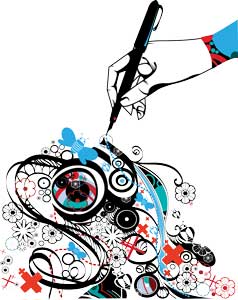 I started out as a package designer in 1960. Magic Marker was the medium, and beautiful and trustworthy was the message. Looking back on the ‘60s, packaging design was really in the last stages of the post-war boom, when marketing and sales efforts still focused on promoting single lines or individual brands.
I started out as a package designer in 1960. Magic Marker was the medium, and beautiful and trustworthy was the message. Looking back on the ‘60s, packaging design was really in the last stages of the post-war boom, when marketing and sales efforts still focused on promoting single lines or individual brands.
Packaging design of the ‘60s was mostly four-color process litho sheets laminated to corrugate. Designs tended to be simple and memorable, like the classic Corning cornflower, which consumers instantly recognized and adored. Coupled with the advanced technology of CorningWare, the “blue cornflower” brand enjoyed unprecedented loyalty and trust, which allowed it to dominate the category in the ‘70s with such leading brand-name products as Corelle, CorningWare and Pyrex, followed by Revere Ware and Visions in the ‘80s.
>Marrying Consumer and Brand
Although the marketing language of the ‘60s still addressed “housewives” and visual communication aimed at “marrying” the consumer to the brand, lifestyles were already changing by quantum leaps. If you remember the ‘60s after JFK, your pop cultural icons were likely The Beatles, Joan Baez, Andy Warhol, Aquarian Age bell-bottoms, “The Flinstones” and Swanson’s TV Dinners.
Packaging design, naturally, reflected a variety of lifestyles in the same spirit of freedom — imaginative color combinations emerged to break all existing rules. When Twiggy was frontlining fashion pages with chartreuse and shocking pink miniskirts, consumer products began to display Day-Glo colors and bold graphics. Dunkin’ Donuts, with its classic ‘60s pink-orange proprietary brand identity was, in 1965, only ten years into the franchise business and exemplified the spirit of ‘60s brand design.
Technological growth in the ‘60s made convenience the buzzword in every sector of the consumer market. Brands such as Birds Eye, Tang, Shake’n Bake and Clorox Bleach were leaders for General Foods and Clorox, each selling on the strength of their individual, stand-alone brand image and building substantial market equity by their dominating visual impact in the sector.
>Toward a Personal Brand Relationship
In the early ‘60s, the approach to packaging design reflected a personal relationship between the consumer and the brand: Designs were intended to develop a proprietary interest among consumers. In addition, consumers returned the favor by referring to products as “their” brands. Brands were equated with performance and price — attributes reflected in the package that made such long-term commitment possible in an era before niche, multi-tier and co-marketing. Market segmentation, co-brand packaging design, packaging brands for global markets and brand management systems were still 25-35 years away.
In the Watergate decade of the ‘70s, a time that showed significant changes in lifestyle and consumer needs, coupled with an explosion of Space-Age technology, new products in every major consumer category flooded the market. A new concept in no-frills product marketing also emerged, resulting in generic packaging, and new terms were coined to reflect shifting demographics — baby boomers pretty much owned the market.
As the number of products evolved and came to market, brand packaging design became more complex with an added dimension — identity. In the ‘70s, the product often eclipsed the brand name. Products previously known ubiquitously and simply by the company name, such as Corning, refocused the marketing tracks to promote individual items under the brand name, and in doing so, created a stronghold for sub-branding with CorningWare Grab-It, French White and Corelle.
>The Revolutionary Eighties
In the world of packaging design, the ‘80s seem light-years ago — but it was a revolutionary time for our industry. We traded in our Magic Markers for our first computer graphics equipment in 1980 while many of our clients traded in their subsidiaries. Ergonomics and global villages became the buzzwords, and “Star Trek: The Next Generation” entertained Generation X.
For the first time in U.S. history, young adults ages 12-19 became the largest demographic group with unprecedented purchasing influence on the market, a trend that continued to spiral upward with teen spending reaching $155 billion in 2000.
Throughout the ‘80s, corporate buying and selling of brands accelerated creation of new marketing opportunities and brought new challenges to packaging designers. The ‘80s trend towards egocentric consumerism opened up new niche markets in the health and fitness arena. Health-oriented (low fat/reduced fat) product entries began to emerge in mainstream food and beverage consumer products.
>Enter Strategic Design
Moreover, with the proliferation of product offerings, consumers no longer restricted themselves to shopping any one brand. More than ever, brand packaging design sought to be alluring and striking to attract consumers while simultaneously communicating the product’s identity, end-benefits and selling it — all in the 30 seconds traditionally allocated by a consumer shopping the aisle. In supermarkets, generic packaging also assumed brand identity in the form of proprietary private labels like D’Agostino’s President’s Choice. This proliferation resulted in the development of strategic marketing and design plans to meet short- and long-term visions for the brand, for both the domestic and global markets.
Häagen-Dazs’ strategic packaging redesign is a good example of the ‘80s shift in brand management. Häagen-Dazs came to us in 1985 for a redesign of its ice cream brand. The brand’s vision already anticipated eventual new multiline product entries, and our mandate was to create an umbrella branding system for present and future products.
Häagen-Dazs already had built-in 30-year equity in its reputation as the maker of premium ice cream. However, research discovered that consumers had only the vaguest recall of the Häagen-Dazs look, although all test subjects knew how to find it in the freezer case. Yet, if the redesign was to be a radical departure from what consumers were accustomed to, it could lose its existing customer base. Our solution was to reinvent the Häagen-Dazs image by endowing it with an upscale elegance in alignment with its super-premium quality product positioning. A branding system was created to ensure instant recognition, which included streamlining the brand name for legibility and encapsulating the name in a cartouche-type mnemonic device. Its former “something-or-other” background was recreated as a lacy doily on a gold background, which further enhanced the products’ overall visual appeal. This was applied to Häagen-Dazs’ baseline ice cream and ice cream bar products with flavor differentiation achieved by flavor bands.
The net effect of the redesign was vastly superior, yet evolutionary, as intended. The next step in the branding evolution took place in 1990, which moved the brand securely into its long-term vision. A rich, deep chocolate-colored background, framed by the original doily, elevated the brand image in line with its super-premium price point and perfectly positioned it to thrive in the emerging indulgence market. In response to direct competition from Ben & Jerry’s filled ice-cream products (Chocolate Chip Cookie Dough, Cherry Garcia, etc.), Häagen-Dazs entered the market with Häagen-Dazs Extraas — followed by sorbets, a response to consumer preferences for a lighter alternative. This timely redesign of the entire Häagen-Dazs line enabled the brand to dominate the sector by 1995. To this day, the brand dress retains the cartouche brand mark and elements of the iconic doily.
The current buzzwords like functional attributes, cyberage, brandscapes and mega-branding have resulted in packaging design challenges unique to this time. National brands are frequently managed by several divisions, each with its own marketing vision and communication hierarchy mandates. To create a unified brand design synergy across the board now requires a clear definition of the brand’s overall identity, its directional goals and a unified set of marketing objectives.
Another issue for brand packaging design today is the dichotomy between the tangible package and its web image — they may look similar, but, in fact, brand design for the web is likely to be merely “cool” and beautiful while ignoring the customer’s needs. Most major brands’ websites are masterfully designed, but they show little market research as to what consumers really want from a brand on its website.
Looking back over almost 40 years, I’ve heard the buzzwords and seen the trends; they’re like flotsam and jetsam. I’ve always believed good design is timeless. The difference between great brands, for example, McDonald’s, Coca-Cola, Disney, Kodak and Levi’s, and brands that fade with declining trends, is their ability to endure — the ability to recognize, assess and respond in a timely manner to the shifts in consumer needs, which occur almost daily. It requires more than just being in the right place at the right time. It takes a trained eye and a mind attuned to constant change to know how much, how far and how fast to calibrate the design adjustments needed to keep a brand as fresh and promising today as it was in the ‘60s.
We may have moved from coins and in-person banking to e-money, online buying, i-marketing and other electronic services, and, inevitably, to online branding, but the ancient adage “life is change” is still fundamental to design. Trends come and go with the rhythmic changes of lifestyle. However, trends don’t sell consumer products in the long run. It’s the astute partnership of good marketing and good design that secures a significant share of market, and it’s the integrity of the design that sustains the brand through transitions. That’s why they are brand champions.
The essence of my message as a designer is that the horizon can never be reached. There are always new design challenges and new marketing heights to conquer. Brand packaging design remains a long-term investment, and the integrity of the design is a brand’s only anchor in a shifting world of competing products and saturated markets.
In a way, some things never change, like good design. They don’t just fade away. They simply get better.

